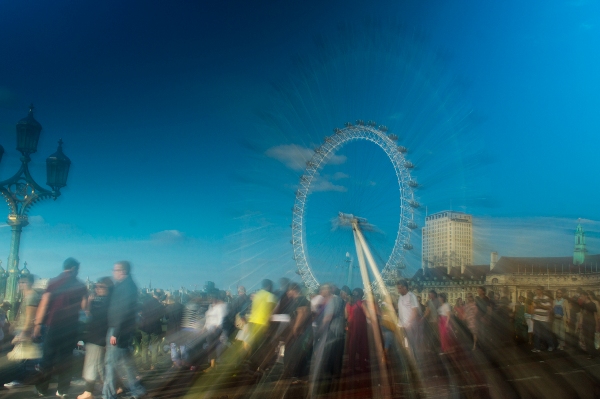
Whenever I see the view of the London Eye from Westminster Bridge I’m reminded of the conmen who often sit along its busy eastern pavement. A line of men and women perform the ages-old scam of inviting punters to guess under which of the three cups they have hidden a ball. The crowd around each hustler is inevitably made mostly up of their own stooges, with £20 notes passing back and forth as the combination of good and bad guesses is elaborately played out to entice members of the public to play. It’s such an obvious con that you’d think nobody would fall for it, but the number of players suggests that there are plenty of takers for a game in which there will only ever be one winner.
The hustlers stay away from Westminster Bridge in the dead of winter and it’s at these times that the view from the bridge can be enjoyed in relative peace. Of course the London Eye dominates the skyline of the South Bank, yet until the late 1990s the photos taken from the bridge by the vast majority of tourists were set against the backdrop of the Houses of Parliament and Big Ben.
A little over 200 years old, William Wordsworth wrote of Westminster Bridge,
“Earth has not anything to show more fair:
Dull would he be of soul who could pass by
A sight so touching in its majesty:
This City now doth, like a garment, wear.
The beauty of the morning: silent, bare,
Ships, towers, domes, theatres, and temples lie
Open unto the fields, and to the sky;
All bright and glittering in the smokeless air.”
Wordsworth didn’t have the railway line from Charing Cross to contend with, let alone the London Eye. Even the Palace of Westminster existed in a completely different form, with the current design only being built after a major fire destroyed the medieval building in 1834.
In Wordsworth’s day many considered crossing over to the south of the river as an entry to a world of slums, disease and immorality. Even in the post-war years there was little reason for a tourist to cross the river. Ward Lock’s guide to London (1951) affords a brief mention to County Hall but otherwise a reader would be excused for thinking London ended abruptly at the Thames.
No doubt Wordsworth would have chosen different words to describe today’s Westminster Bridge, yet despite the changes that London has undergone since his day this otherwise unremarkable bridge remains one of London’s most visited landmarks; the hustlers with the fast hands and £20 notes are just another part of its long and colourful history.





Just want to say I really like the picture. Nicely done with a bit of history about London.. It reminds me my last holidays in UK, always happy to go back.